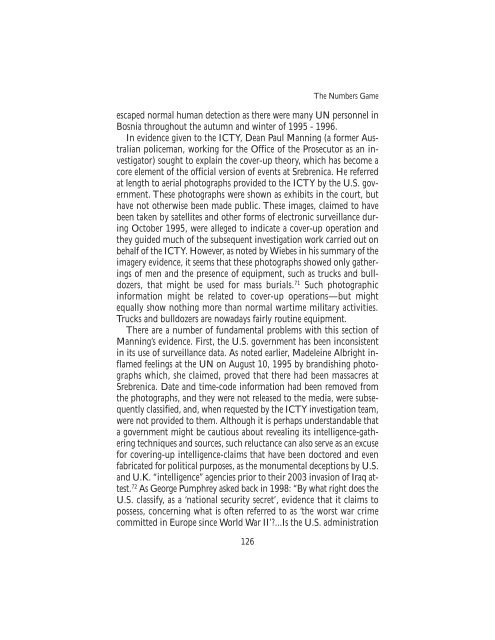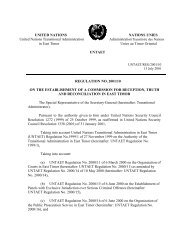The Srebrenica Massacre - Nova Srpska Politicka Misao
The Srebrenica Massacre - Nova Srpska Politicka Misao
The Srebrenica Massacre - Nova Srpska Politicka Misao
Create successful ePaper yourself
Turn your PDF publications into a flip-book with our unique Google optimized e-Paper software.
<strong>The</strong> Numbers Game<br />
escaped normal human detection as there were many UN personnel in<br />
Bosnia throughout the autumn and winter of 1995 - 1996.<br />
In evidence given to the ICTY, Dean Paul Manning (a former Australian<br />
policeman, working for the Office of the Prosecutor as an investigator)<br />
sought to explain the cover-up theory, which has become a<br />
core element of the official version of events at <strong>Srebrenica</strong>. He referred<br />
at length to aerial photographs provided to the ICTY by the U.S. government.<br />
<strong>The</strong>se photographs were shown as exhibits in the court, but<br />
have not otherwise been made public. <strong>The</strong>se images, claimed to have<br />
been taken by satellites and other forms of electronic surveillance during<br />
October 1995, were alleged to indicate a cover-up operation and<br />
they guided much of the subsequent investigation work carried out on<br />
behalf of the ICTY. However, as noted by Wiebes in his summary of the<br />
imagery evidence, it seems that these photographs showed only gatherings<br />
of men and the presence of equipment, such as trucks and bulldozers,<br />
that might be used for mass burials. 71 Such photographic<br />
information might be related to cover-up operations—but might<br />
equally show nothing more than normal wartime military activities.<br />
Trucks and bulldozers are nowadays fairly routine equipment.<br />
<strong>The</strong>re are a number of fundamental problems with this section of<br />
Manning’s evidence. First, the U.S. government has been inconsistent<br />
in its use of surveillance data. As noted earlier, Madeleine Albright inflamed<br />
feelings at the UN on August 10, 1995 by brandishing photographs<br />
which, she claimed, proved that there had been massacres at<br />
<strong>Srebrenica</strong>. Date and time-code information had been removed from<br />
the photographs, and they were not released to the media, were subsequently<br />
classified, and, when requested by the ICTY investigation team,<br />
were not provided to them. Although it is perhaps understandable that<br />
a government might be cautious about revealing its intelligence-gathering<br />
techniques and sources, such reluctance can also serve as an excuse<br />
for covering-up intelligence-claims that have been doctored and even<br />
fabricated for political purposes, as the monumental deceptions by U.S.<br />
and U.K. “intelligence” agencies prior to their 2003 invasion of Iraq attest.<br />
72 As George Pumphrey asked back in 1998: “By what right does the<br />
U.S. classify, as a ‘national security secret’, evidence that it claims to<br />
possess, concerning what is often referred to as ‘the worst war crime<br />
committed in Europe since World War II’?...Is the U.S. administration<br />
126



